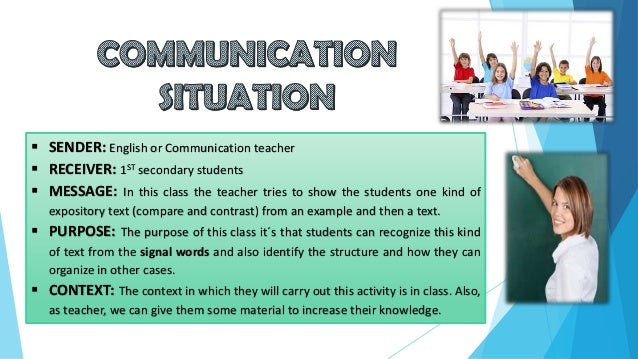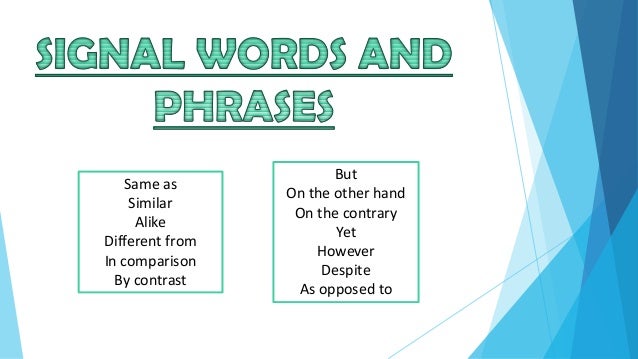
Have students reconvene in their small groups to locate the compare and contrast information within a larger text selection. Distribute copies of the compare and contrast text that you would like them to read. This text can come from your own textbooks or from these suggested Internet Articles Written in the Compare and Contrast Format. Have students read the text independently and then work with their groups to create a list of the ideas and facts that are being compared and contrasted Expository texts often include lists -- sometimes enumerated with bullet points -- of comparisons and contrasts as well as causes and effects 6/28/ · SENDER: English or Communication teacher RECEIVER: 1ST secondary students MESSAGE: In this class the teacher tries to show the students one kind of expository text (compare and contrast) from an example and then a text. PURPOSE: The purpose of this class it´s that students can recognize this kind of text from the signal words and also identify the structure and how they can
How Is Narrative Different From Expository Text? | Pen and the Pad
Print This Page. See more like this. ReadWriteThink couldn't publish all expository text compare and contrast this great content without literacy experts to write and review for us. If you've got lessons plans, videos, activities, or other ideas you'd like to contribute, we'd love to hear from you, expository text compare and contrast. Find the latest in professional publications, learn new techniques and strategies, and find out how you can connect with other literacy professionals.
Emily Manning. Session 1: Understanding Compare and Contrast. Session 2: Identifying Texts that Compare and Contrast Items. Session 3: Comparing and Contrasting Items Within a Text. back to top. All rights expository text compare and contrast. Technical Help Legal International Literacy Association National Council of Teachers of English. html Print This Page, expository text compare and contrast. Lesson Plans Student Interactives Mobile Apps Calendar Activities Printouts.
Literacy in Action Presentations Using RWT Just for Fun. Kindergarten Grades 1 - 2 Grades 3 - 4 Grades 5 - 6 Grades 7 - 8 Grades 9 - 10 Grades 11 - SEARCH BY KEYWORD. Teacher Resources by Grade. Your students can save their work with Student Interactives. US NEWSVINE TWITTER. Grades 3 — 5 Lesson Plan Type Standard Lesson Estimated Time Four to minute sessions Lesson Author.
Emily Manning Denton, Texas. Write the words house and nest on the board or chart paper. Make two columns and label the column on the left Compare same and the column on the right Contrast different. If possible, have a picture of a house and a nest to support your English-language learning ELL students.
Have students express all of the similarities and differences between these two shelters and write them on the chart in the appropriate column. Your class chart may resemble the chart below: Compare same Contrast different Both are shelters.
Nests are usually smaller than houses; houses are bigger than nests. Birds make their nests just like humans make their homes. A house has a roof. Both use trees. Humans use lumber from trees; birds use twigs and branches.
A nest is a place for the bird to lay an egg. Both can shelter more than one inhabitant. Nests are simple; houses are more complex. Both take up space. Houses usually have more than one room in them. Both have to be taken care of. Birds might repair a hole; humans might repair a leak. A bird can live in a house as a pet; humans don’t live in nests as pets.
Instructional Plan. Your class chart may resemble the chart below: Compare same. Contrast different. Discuss the terms compare and contrast. ReadWriteThink’s Comparison and Contrast Guide can be used to help explain these terms. View the online guide using an LCD projector or gather your students around the classroom computer. The first nine slides of the Comparison and Contrast Guide – encompassing the Overview, Definition, and Example tabs – are most appropriate for this discussion.
After sharing the Comparison and Contrast Guide, explain to students that expository text compare and contrast are going to compare and contrast items in cooperative groups.
Divide the class into small groups and give each group a sheet of paper and one expository text compare and contrast card that you prepared in advance see Preparation, Step 1.
If possible have pictures or the actual objects named on the index cards available for students who need extra support. Instruct groups expository text compare and contrast draw two columns on the paper and write the words Compare same on top of the left-hand column and Contrast different on top of the right-hand column.
Refer to the chart you just completed with the class as a model. Explain to students that they will now list all of the characteristics that are the same about the items and all of the characteristics that are different.
Have students present their lists to the class. Allow students in other groups to suggest additions and changes to the lists. Give each student a Compare and Contrast Tool Kit. Read through the worksheet with students and explain how they can use clue words to find the ideas and facts that two items have in common as well as those ideas and facts that are unique to each item. Comparison clue words include similarbothand alike ; contrast clue words include differentbutand instead of.
Have students brainstorm other words that are used to express things that are similar or different. On an LCD projector, project the Nests and Houses PowerPoint presentation for students to view, or distribute copies of the slides see Preparation, Step 3. Read the paragraph aloud to your class, stopping throughout to think aloud. Modeling your thinking will provide the support that your struggling readers need. For example, expository text compare and contrast, while reading the paragraph you might share thoughts like the following: “The first sentence says that there are major differences between houses and nests.
The way that the sentence is worded makes me think that this paragraph is going to contrast houses and nests, expository text compare and contrast. The way the author uses “same” in that sentence makes me think that this next part will tell me some things that are the same about nests and houses. After reading the paragraph on Slide 2, go to Slide 3 and follow the directions. This involves locating keywords that signal that the paragraph is organized in a compare and contrast format.
Ask students to use their Compare and Contrast Tool Kit to help remember what the clue words are. Students can check their work on Slide 4; the clue words are highlighted within the paragraph. Now that your students have practiced working through a paragraph together, tell them that they are going to work in small groups to practice identifying compare and contrast paragraphs.
Divide the class into small groups and distribute copies of the four Paragraph Practice sheets. Have students read the text independently, expository text compare and contrast, then work with their groups to answer the questions below each paragraph. Remind students to use their Compare and Contrast Tool Kit as a guide. Note: Take time before this session to read these paragraphs with your struggling and ELL students.
Discuss the content, show photographs of the different houses discussed in each paragraph, expository text compare and contrast, and try to build their background knowledge before they read in their small groups. Taking time to build background knowledge will allow your struggling and ELL students to focus on the compare and contrast structure when working with their small groups.
Circulate among the groups as they work, focus discussions as needed, and make notes of groups that are able to identify compare and contrast paragraphs and groups that are having difficulty doing this. Once all the small groups have had time to read and discuss the paragraphs, lead a class discussion about the four paragraphs and students’ use of clue words to locate comparing and contrasting information.
Also ask students if there are any new clue words that should be added to the Compare and Contrast Tool Kit. Review the Compare and Contrast Tool Kit by reading through it and asking students to give examples of how the clue words were used in the paragraphs they read in the previous session. Have students reconvene in their small groups to locate the expository text compare and contrast and contrast information within a larger text selection.
Distribute copies of the compare and contrast text that you would like them to read. This text can come from your own textbooks or from these suggested Internet Articles Written in the Compare and Contrast Format, expository text compare and contrast. Have students read the expository text compare and contrast independently and then work with their groups to create a list of the ideas and facts that are being compared and contrasted.
Pair students who need extra support in reading with a student or adult or provide a recording of the text selection on tape. Remind small groups to use their Compare and Contrast Tool Kit for reference.
Circulate among the groups as they work, focus discussions as needed, and observe group interactions using the Group Skills Tracking Sheet. After small groups have had time to read and generate their list of ideas and facts, gather the class together for a whole-group discussion, expository text compare and contrast.
Ask groups to present their list to the class and explain what the author was comparing and contrasting. Challenge groups to prove their thinking by supporting their thoughts with evidence such as clue words from the text. Review the similarities and differences from the texts students read during Session 3, expository text compare and contrast.
Explain that there is another way to show comparing and contrasting ideas. Draw two overlapping circles a Venn diagram on the board or chart paper. Ask if anyone knows what kind of diagram it is. Explain that Venn diagrams are useful when comparing and contrasting two subjects, two places, two things, expository text compare and contrast, or even two people. Explain that the outer circles are intended for contrasting information; that is, the ideas and facts that are different about or unique to each item.
The middle area where the circles overlap is reserved for comparisons; the ideas and facts that the expository text compare and contrast items have in common. Recall your discussion during Session 1 about the similarities and differences between nests and houses. Label one outer circle of your Venn diagram neststhe other outer circle housesand the overlapping circle both.
Identify important details in Expository Text listened to-Grade 2-English 2- Week 5 Quarter 3- PIVOT
, time: 22:33Exploring Compare and Contrast Structure in Expository Texts - ReadWriteThink

Expository texts often include lists -- sometimes enumerated with bullet points -- of comparisons and contrasts as well as causes and effects Typical Text Structures of Expository Text; Cause and Effect: Ideas, events in time, or facts are presented as causes of the resulting effect(s) or facts that happen as a result of an event. Compare and Contrast: Information is presented by detailing how two or more events, concepts, theories, or things are alike and/or different. Description Expository Writing: The Compare and Contrast Essay. Introduction & Objective: Students will take information acquired about Día de los Muertos and apply their knowledge of either Hal-loween or Memorial Day to create a Venn Diagram and Compare and Contrast Essay. Oftentimes thereFile Size: KB

No comments:
Post a Comment